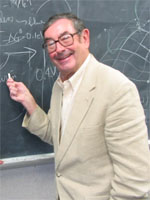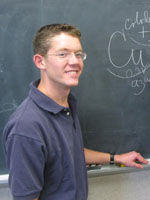
Harry B. Gray
California Institute of Technology

John S. Magyar
California Institute of Technology
A Lively Field from Lively Meetings
Harry Gray
The field of bioinorganic chemistry and the Metals in Biology (MIB) Gordon Conference have grown hand-in-hand since the 1960s, when biologists and biochemists like Paul Saltman and Bert Vallee began to realize the importance of inorganic compounds in their work. Paul Saltman was the principal mover and shaker who made the MIB Gordon Conference, which began in 1962, the very successful gathering of the faithful that we know and love today. What an impression Paul made! I had the misfortune of being scheduled to speak after Paul at one of the early MIBs; Paul had the audience so in tears from laughing that my talk was a loser from the start. Chemist Jack Halpern yelled from the front row, “Harry, you’re no match for Paul!” Indeed I wasn’t, but bioinorganic chemistry was moving so fast I didn’t worry about it!
In the 1960s and 1970s MIB sometimes became a battlefield for debate between inorganic chemists and chemical biologists. We had to rotate the chairs, one meeting chaired by a biochemist, the next by an inorganic chemist. The field of biological inorganic chemistry, however, would not have coalesced in the same way if it were not for the Gordon Conferences. Leading scientists would never have gotten together and duked it out in another setting. At the Gordon Conferences they were confined for a week and forced to talk to each other, so it couldn’t not happen.
By the mid-1990s MIB had become very popular and far oversubscribed. Nearly all the participants were established investigators; few graduate students or postdocs applied to attend, as there was little chance they would be accepted. Members of the GRC board, while pleased with the overall success of MIB, were concerned about the lack of student participation. Carl Storm, then the GRC director, took the initiative and proposed that GRC hold a Bioinorganic Chemistry Graduate Research Seminar (GRS).
On Carl’s request Joan Valentine (who was on the Selection and Scheduling Committee at that time) re-cruited Edward H. Ha, a student from her group at the University of California at Los Angeles (UCLA), to organize the first GRS meeting in 1996. Ha and Joy Goto, also of UCLA, cochaired the meeting, assisted by Gretchen Meister (UC Santa Barbara) and Ben Ramirez (California Institute of Technology). Reviews of the first meeting were glowing. Monitors John Law and Alan Cowley recommended not only that the Bioinorganic Chemistry GRS continue but also that GRC consider proposals for student-run additions to other Gordon Conferences. Law and Cowley should be happy to know that participation in the Bioinorganic GRS grew from 62 attendees in 1996 to 102 in 2004 and that two new Graduate Research Seminars, Molecular Energy Transfer and Analytical Chemistry, took place in 2005. The success of the Bioinorganic GRS is also demonstrated by its longevity: GRC’s seventy-fifth anniversary coincides with GRS’s tenth!
John Magyar
From the beginning, students attending the Bioinorganic GRS have benefited from the strong support of both the GRC organization and MIB participants. The bioinorganic chemistry community that has developed over the years at MIB warmly welcomes the students. Everyone is energized by the incredible infusion of enthusiasm that arrives with the influx of young scientists. Thursday evening at MIB is a joint MIB-GRS session, with dinner followed by a talk from a distinguished bioinorganic chemist. The evening poster session is a “show and tell” by the student participants. The entire evening has become a terrific opportunity for students to meet and interact with established researchers, and vice versa! This interaction can be extraordinarily valuable for young investigators. Discussions I had as a student at these meetings have led to critical insights, new interpretations, several exceedingly fruitful collaborations, and many new friends.
Most, but not all, of the MIB conferees depart on Friday morning. A few remain, either as discussion leaders or simply because they enjoy the student conference. (Several professors have remarked after their first GRS experience that in the future, they would consider skipping MIB entirely and only attend the student meeting!) From Friday on, all the speakers and most of the participants are grad students or postdocs. The atmosphere is not at all intimidating, leading to lively discussion and broad participation, and students get to know their peers in bioinorganic chemistry, people who will be their colleagues for decades to come.
The strong support of the MIB community for the GRS is also evident in other ways. As 2004 GRS chair, I was thrilled that nearly every discussion leader I invited immediately and enthusiastically agreed. When I asked professors to suggest students to speak, I was inundated with recommendations. In addition, the MIB chair is a mentor to the GRS chair, a relationship that can be very valuable to a young first-time meeting organizer.
The huge MIB participation in the Thursday-night poster session demonstrates both the vibrancy of the bioinorganic community and its strong support for young investigators. Every year both the poster room and the hallways are packed with conferees in highly animated discussions of science. The Gordon Conferences played an important part in the birth of bioinorganic chemistry, and they continue today to sustain the growth of this field.